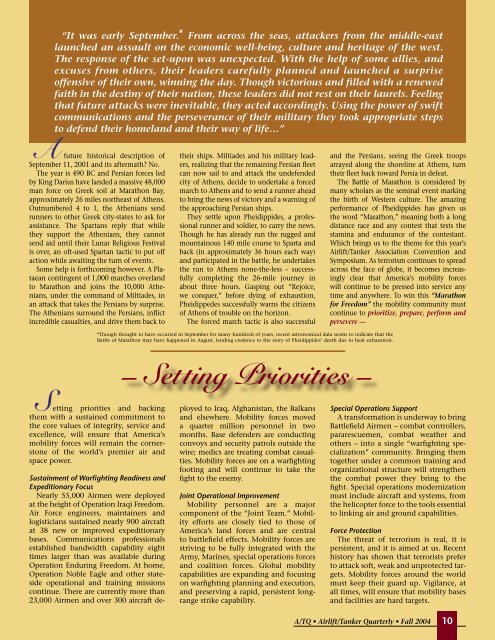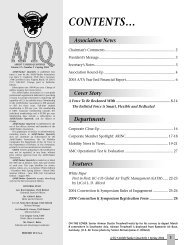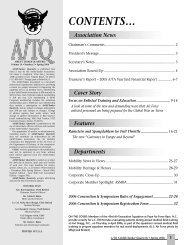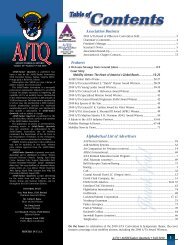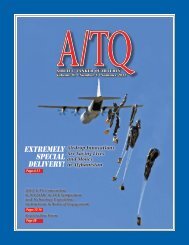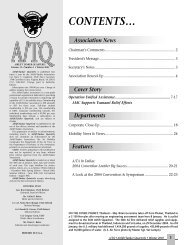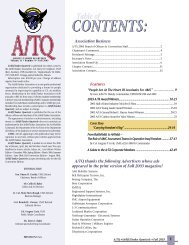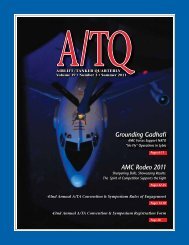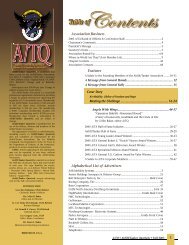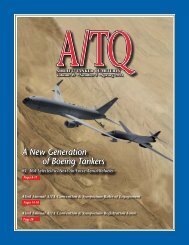ATQ Fall 2004 (pages) for pdf - Airlift/Tanker Association
ATQ Fall 2004 (pages) for pdf - Airlift/Tanker Association
ATQ Fall 2004 (pages) for pdf - Airlift/Tanker Association
You also want an ePaper? Increase the reach of your titles
YUMPU automatically turns print PDFs into web optimized ePapers that Google loves.
“It was early September. * From across the seas, attackers from the middle-east<br />
launched an assault on the economic well-being, culture and heritage of the west.<br />
The response of the set-upon was unexpected. With the help of some allies, and<br />
excuses from others, their leaders carefully planned and launched a surprise<br />
offensive of their own, winning the day. Though victorious and filled with a renewed<br />
faith in the destiny of their nation, these leaders did not rest on their laurels. Feeling<br />
that future attacks were inevitable, they acted accordingly. Using the power of swift<br />
communications and the perseverance of their military they took appropriate steps<br />
to defend their homeland and their way of life…”<br />
A future historical description of<br />
September 11, 2001 and its aftermath? No.<br />
The year is 490 BC and Persian <strong>for</strong>ces led<br />
by King Darius have landed a massive 48,000<br />
man <strong>for</strong>ce on Greek soil at Marathon Bay,<br />
approximately 26 miles northeast of Athens.<br />
Outnumbered 4 to 1, the Athenians send<br />
runners to other Greek city-states to ask <strong>for</strong><br />
assistance. The Spartans reply that while<br />
they support the Athenians, they cannot<br />
send aid until their Lunar Religious Festival<br />
is over, an oft-used Spartan tactic to put off<br />
action while awaiting the turn of events.<br />
Some help is <strong>for</strong>thcoming however. A Plataean<br />
contingent of 1,000 marches overland<br />
to Marathon and joins the 10,000 Athenians,<br />
under the command of Miltiades, in<br />
an attack that takes the Persians by surprise.<br />
The Athenians surround the Persians, inflict<br />
incredible casualties, and drive them back to<br />
their ships. Miltiades and his military leaders,<br />
realizing that the remaining Persian fleet<br />
can now sail to and attack the undefended<br />
city of Athens, decide to undertake a <strong>for</strong>ced<br />
march to Athens and to send a runner ahead<br />
to bring the news of victory and a warning of<br />
the approaching Persian ships.<br />
They settle upon Pheidippides, a professional<br />
runner and soldier, to carry the news.<br />
Though he has already run the rugged and<br />
mountainous 140 mile course to Sparta and<br />
back (in approximately 36 hours each way)<br />
and participated in the battle, he undertakes<br />
the run to Athens none-the-less – successfully<br />
completing the 26-mile journey in<br />
about three hours. Gasping out “Rejoice,<br />
we conquer,” be<strong>for</strong>e dying of exhaustion,<br />
Pheidippedes successfully warns the citizens<br />
of Athens of trouble on the horizon.<br />
The <strong>for</strong>ced march tactic is also successful<br />
*Though thought to have occurred in September <strong>for</strong> many hundreds of years, recent astronomical data seems to indicate that the<br />
Battle of Marathon may have happened in August, lending credence to the story of Pheidippides’ death due to heat exhaustion.<br />
and the Persians, seeing the Greek troops<br />
arrayed along the shoreline at Athens, turn<br />
their fleet back toward Persia in defeat.<br />
The Battle of Marathon is considered by<br />
many scholars as the seminal event marking<br />
the birth of Western culture. The amazing<br />
per<strong>for</strong>mance of Pheidippides has given us<br />
the word “Marathon,” meaning both a long<br />
distance race and any contest that tests the<br />
stamina and endurance of the contestant.<br />
Which brings us to the theme <strong>for</strong> this year’s<br />
<strong>Airlift</strong>/<strong>Tanker</strong> <strong>Association</strong> Convention and<br />
Symposium. As terrorism continues to spread<br />
across the face of globe, it becomes increasingly<br />
clear that America’s mobility <strong>for</strong>ces<br />
will continue to be pressed into service any<br />
time and anywhere. To win this “Marathon<br />
<strong>for</strong> Freedom” the mobility community must<br />
continue to prioritize, prepare, per<strong>for</strong>m and<br />
persevere —<br />
– Setting Priorities –<br />
Setting priorities and backing<br />
them with a sustained commitment to<br />
the core values of integrity, service and<br />
excellence, will ensure that America’s<br />
mobility <strong>for</strong>ces will remain the cornerstone<br />
of the world’s premier air and<br />
space power.<br />
Sustainment of Warfighting Readiness and<br />
Expeditionary Focus<br />
Nearly 55,000 Airmen were deployed<br />
at the height of Operation Iraqi Freedom.<br />
Air Force engineers, maintainers and<br />
logisticians sustained nearly 900 aircraft<br />
at 38 new or improved expeditionary<br />
bases. Communications professionals<br />
established bandwidth capability eight<br />
times larger than was available during<br />
Operation Enduring Freedom. At home,<br />
Operation Noble Eagle and other stateside<br />
operational and training missions<br />
continue. There are currently more than<br />
23,000 Airmen and over 300 aircraft deployed<br />
to Iraq, Afghanistan, the Balkans<br />
and elsewhere. Mobility <strong>for</strong>ces moved<br />
a quarter million personnel in two<br />
months. Base defenders are conducting<br />
convoys and security patrols outside the<br />
wire; medics are treating combat casualties.<br />
Mobility <strong>for</strong>ces are on a warfighting<br />
footing and will continue to take the<br />
fight to the enemy.<br />
Joint Operational Improvement<br />
Mobility personnel are a major<br />
component of the “Joint Team.” Mobility<br />
ef<strong>for</strong>ts are closely tied to those of<br />
America’s land <strong>for</strong>ces and are central<br />
to battlefield effects. Mobility <strong>for</strong>ces are<br />
striving to be fully integrated with the<br />
Army, Marines, special operations <strong>for</strong>ces<br />
and coalition <strong>for</strong>ces. Global mobility<br />
capabilities are expanding and focusing<br />
on warfighting planning and execution,<br />
and preserving a rapid, persistent longrange<br />
strike capability.<br />
Special Operations Support<br />
A trans<strong>for</strong>mation is underway to bring<br />
Battlefield Airmen – combat controllers,<br />
pararescuemen, combat weather and<br />
others – into a single “warfighting specialization”<br />
community. Bringing them<br />
together under a common training and<br />
organizational structure will strengthen<br />
the combat power they bring to the<br />
fight. Special operations modernization<br />
must include aircraft and systems, from<br />
the helicopter <strong>for</strong>ce to the tools essential<br />
to linking air and ground capabilities.<br />
Force Protection<br />
The threat of terrorism is real, it is<br />
persistent, and it is aimed at us. Recent<br />
history has shown that terrorists prefer<br />
to attack soft, weak and unprotected targets.<br />
Mobility <strong>for</strong>ces around the world<br />
must keep their guard up. Vigilance, at<br />
all times, will ensure that mobility bases<br />
and facilities are hard targets.<br />
10 A/TQ • <strong>Airlift</strong>/<strong>Tanker</strong> Quarterly • <strong>Fall</strong> <strong>2004</strong><br />
A/TQ • <strong>Airlift</strong>/<strong>Tanker</strong> Quarterly • <strong>Fall</strong> <strong>2004</strong><br />
10


